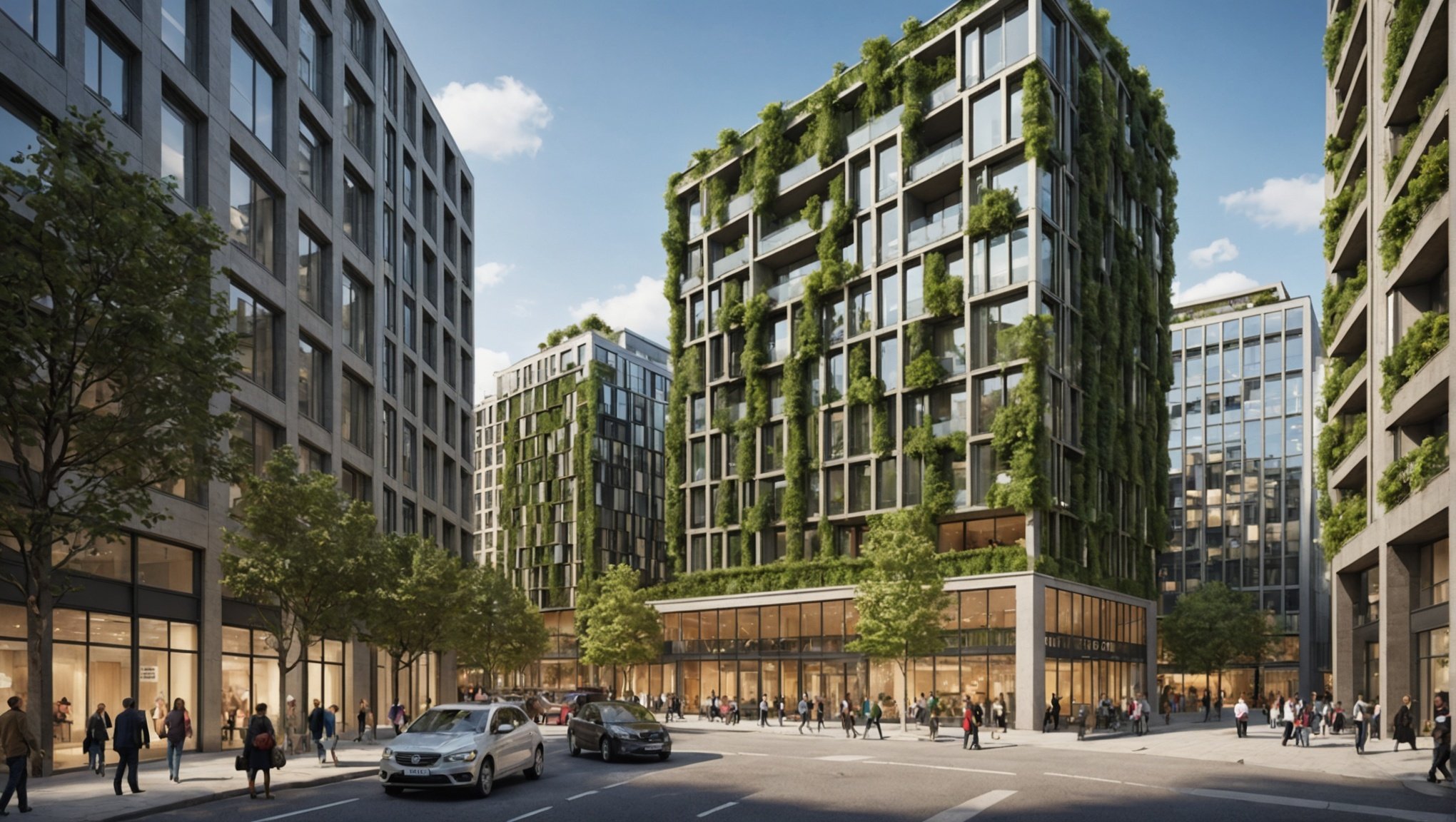Unlocking Savings: The Financial Advantages of Embracing Green Building Standards in Urban Development
As the world grapples with the challenges of climate change, urbanization, and economic sustainability, the importance of green building standards in urban development has never been more evident. Green buildings, with their focus on sustainability, energy efficiency, and environmental stewardship, offer a myriad of financial advantages that can transform the way we build and live in our cities.
The Economic Benefits of Green Buildings
Green buildings are often misconceived as being more expensive than traditional constructions, but the long-term financial benefits far outweigh the initial costs. Here are some key economic advantages of embracing green building standards:
Energy Efficiency and Cost Savings
Green buildings are designed to be energy efficient, which translates into significant cost savings over time. For instance, green roofs, as discussed in the context of urban development, reduce energy consumption by acting as natural insulation, lowering heat loss in winter and heat gain in summer. This results in lower utility bills, a benefit that is both immediate and long-term[5].
| Benefit | Description |
|
|-----------------------------------------------------------------------------|
| Reduced Energy Consumption | Lower utility bills due to natural insulation and efficient design |
| Increased Property Value | Enhanced market value through aesthetic appeal and LEED certification |
| Tax Incentives and Rebates | Government incentives and rebates to offset initial installation costs |
| Lower Maintenance Costs | Durable materials and efficient systems reduce maintenance needs |
| Improved Air Quality | Better indoor air quality enhances occupant health and productivity |
Increased Property Value
Green buildings not only save money on energy but also increase property values. The aesthetic appeal of green roofs, for example, can make a building more attractive to potential buyers and renters. Additionally, buildings with green features can qualify for LEED certification, which further boosts their market value[5].
Also to discover : Overcoming Obstacles: The Quest for Zero-Carbon Homes in Northern UK Regions
Tax Incentives and Rebates
Many governments offer tax incentives and rebates for developers who incorporate green infrastructure into their projects. These financial incentives can significantly reduce the initial costs associated with green building construction, making it more accessible and financially viable[5].
Environmental Impact and Public Health
Beyond the economic benefits, green buildings have a profound impact on the environment and public health.
Reduced Environmental Impact
Green buildings are designed to minimize their environmental footprint. By reducing energy consumption, they lower greenhouse gas emissions, which is crucial in the fight against climate change. For example, a study by the Victoria Transport Policy Institute found that Smart Growth development policies can reduce vehicle travel, building energy consumption, water consumption, and greenhouse gas emissions, while also preserving greenspace and enhancing carbon sequestration[1].
Improved Public Health
The environmental benefits of green buildings also translate into improved public health. Compact urban development, a key aspect of Smart Growth, has been shown to reduce the incidence of heart disease and diabetes by promoting more active lifestyles and better air quality. In Halifax, Nova Scotia, a compact development scenario reduced infrastructure and transportation costs by approximately 10% and improved public health by reducing pollution emissions[1].
Innovative Solutions and Technologies
The adoption of green building standards is driven by innovative solutions and technologies that make sustainable construction more feasible and cost-effective.
Green Roofs and Urban Infrastructure
Green roofs are a prime example of innovative urban infrastructure. They not only reduce energy consumption but also protect local waterways by reducing stormwater runoff and preventing water pollution. Additionally, they enhance biodiversity by providing habitats for local wildlife and improve air quality by absorbing air pollutants[5].
Natural Climate Solutions
Natural Climate Solutions (NCS) are another area where innovation is making a significant impact. NCS involve restoring and preserving natural ecosystems like wetlands and forests, which can be highly cost-effective in reducing emissions and providing multiple socio-economic benefits. For instance, restoring wetlands can serve as cost-effective urban flood management infrastructure, highlighting the economic and environmental benefits of NCS[3].
Practical Insights and Actionable Advice
For those looking to embrace green building standards, here are some practical insights and actionable advice:
Choose Sustainable Materials
Using sustainable materials in construction is a key practice in green building. Materials such as recycled wood, low-VOC paints, and sustainable insulation can reduce the environmental impact of the building while also improving indoor air quality.
Optimize Building Design
Optimizing building design for energy efficiency is crucial. This includes orienting buildings to maximize natural light and heat, using passive solar design principles, and incorporating energy-efficient systems.
Implement Green Financing Options
Green financing options, such as those offered by cooperativas in Puerto Rico, can make green building projects more affordable. These loans often come with lower interest rates and flexible terms, making it easier for developers and homeowners to invest in green technologies[2].
Case Studies and Real-World Examples
Several case studies and real-world examples illustrate the financial advantages of green building standards.
Massachusetts Community Climate Bank
The Massachusetts Community Climate Bank is a pioneering initiative that provides financing for low- and moderate-income homeowners to improve the energy efficiency of their homes. This initiative not only helps in reducing energy costs but also improves the health and safety of the occupants by eliminating indoor air pollutants and making homes more airtight and supported by clean power[2].
Halifax Compact Development Scenario
In Halifax, Nova Scotia, a compact development scenario increased the portion of new housing located in existing urban centers from 25% to 50%. This resulted in a 10% reduction in infrastructure and transportation costs and improved public health by reducing pollution emissions. Such scenarios demonstrate the tangible benefits of compact urban development and green building practices[1].
Embracing green building standards in urban development is not just a moral imperative; it is also a financially savvy decision. From energy efficiency and cost savings to increased property values and improved public health, the benefits of green buildings are multifaceted and significant.
As Maggie Super Church from the Massachusetts Community Climate Bank aptly put it, “When we think about the cost of transitioning to a clean energy economy, we also have to think about all the other associated benefits. Certainly, others have talked about workforce development, wealth creation and preservation, cleaner communities, safer communities, but the health benefits by themselves are really substantial.”
In conclusion, the financial advantages of green building standards are clear and compelling. As we move forward in our urban development endeavors, it is crucial to prioritize sustainability, energy efficiency, and environmental stewardship to create more livable, resilient, and sustainable cities for the future.
### List: Benefits of Green Buildings for Urban Spaces
- **Reduced Urban Heat Island Effect**: Green roofs lower surface temperatures, providing relief from heat.
- **Improved Air Quality**: Vegetation absorbs air pollutants, enhancing air quality.
- **Enhanced Biodiversity**: Provides habitats for local wildlife, increasing urban biodiversity.
- **Water Quality Protection**: Reduces stormwater runoff, preventing water pollution.
- **Energy Efficiency**: Reduces energy consumption, leading to lower utility bills.
- **Increased Property Value**: Enhances property value through aesthetic appeal and LEED certification.
- **Community Engagement**: Can serve as community spaces, fostering social interaction.
- **Carbon Sequestration**: Helps in reducing greenhouse gas emissions.
### Table: Comparative Analysis of Green Building Benefits
| Benefit | Traditional Buildings | Green Buildings |
|
|----------------------|
|
| Energy Consumption | High | Low |
| Property Value | Standard | Enhanced |
| Maintenance Costs | High | Low |
| Indoor Air Quality | Poor | Improved |
| Environmental Impact | High | Low |
| Cost Savings | Minimal | Significant |
| Public Health Benefits | Limited | Substantial |
By embracing green building standards, we can unlock significant financial savings, improve public health, and contribute to a more sustainable future. As we continue to urbanize, it is imperative that we prioritize these practices to ensure our cities remain vibrant, sustainable, and resilient for generations to come.











